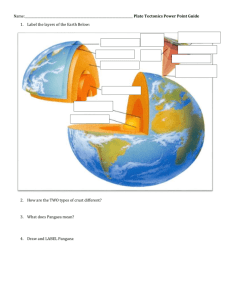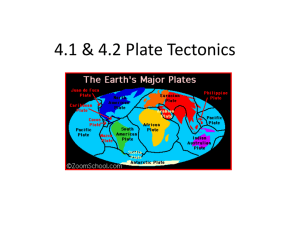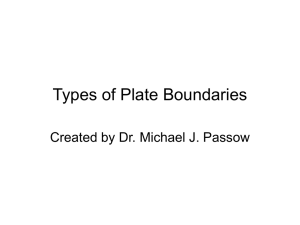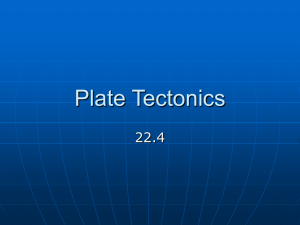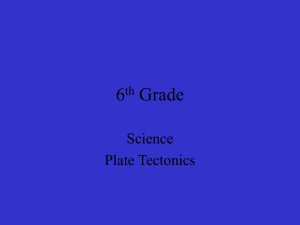F Topic 5 notes - The University of West Georgia
advertisement
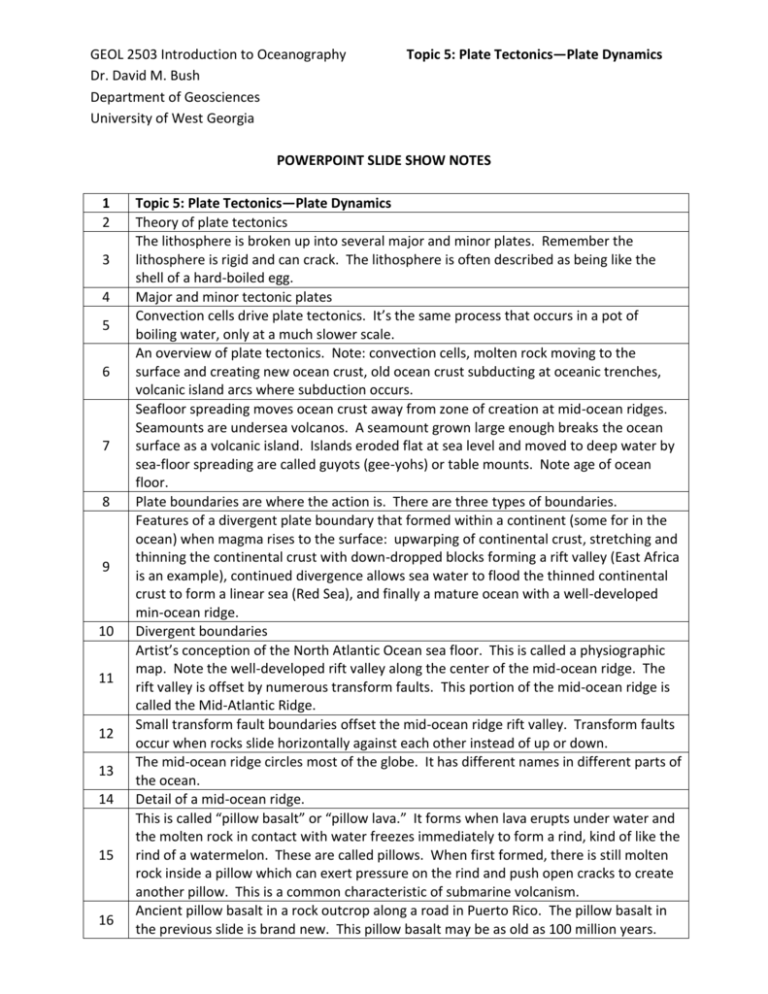
GEOL 2503 Introduction to Oceanography Dr. David M. Bush Department of Geosciences University of West Georgia Topic 5: Plate Tectonics—Plate Dynamics POWERPOINT SLIDE SHOW NOTES 1 2 3 4 5 6 7 8 9 10 11 12 13 14 15 16 Topic 5: Plate Tectonics—Plate Dynamics Theory of plate tectonics The lithosphere is broken up into several major and minor plates. Remember the lithosphere is rigid and can crack. The lithosphere is often described as being like the shell of a hard-boiled egg. Major and minor tectonic plates Convection cells drive plate tectonics. It’s the same process that occurs in a pot of boiling water, only at a much slower scale. An overview of plate tectonics. Note: convection cells, molten rock moving to the surface and creating new ocean crust, old ocean crust subducting at oceanic trenches, volcanic island arcs where subduction occurs. Seafloor spreading moves ocean crust away from zone of creation at mid-ocean ridges. Seamounts are undersea volcanos. A seamount grown large enough breaks the ocean surface as a volcanic island. Islands eroded flat at sea level and moved to deep water by sea-floor spreading are called guyots (gee-yohs) or table mounts. Note age of ocean floor. Plate boundaries are where the action is. There are three types of boundaries. Features of a divergent plate boundary that formed within a continent (some for in the ocean) when magma rises to the surface: upwarping of continental crust, stretching and thinning the continental crust with down-dropped blocks forming a rift valley (East Africa is an example), continued divergence allows sea water to flood the thinned continental crust to form a linear sea (Red Sea), and finally a mature ocean with a well-developed min-ocean ridge. Divergent boundaries Artist’s conception of the North Atlantic Ocean sea floor. This is called a physiographic map. Note the well-developed rift valley along the center of the mid-ocean ridge. The rift valley is offset by numerous transform faults. This portion of the mid-ocean ridge is called the Mid-Atlantic Ridge. Small transform fault boundaries offset the mid-ocean ridge rift valley. Transform faults occur when rocks slide horizontally against each other instead of up or down. The mid-ocean ridge circles most of the globe. It has different names in different parts of the ocean. Detail of a mid-ocean ridge. This is called “pillow basalt” or “pillow lava.” It forms when lava erupts under water and the molten rock in contact with water freezes immediately to form a rind, kind of like the rind of a watermelon. These are called pillows. When first formed, there is still molten rock inside a pillow which can exert pressure on the rind and push open cracks to create another pillow. This is a common characteristic of submarine volcanism. Ancient pillow basalt in a rock outcrop along a road in Puerto Rico. The pillow basalt in the previous slide is brand new. This pillow basalt may be as old as 100 million years. 17 18 19 20 21 22 23 24 25 26 27 28 29 30 31 32 33 34 35 36 37 38 39 Another photo of the pillow basalt from Puerto Rico. Note the “rind” surrounding some of the pillows has weathered away. Young ocean crust is warm and has a low density so it is up at a higher level than the surrounding sea floor (look back at slide 9, figure d). Conversely, as the ocean crust moves (spreads) away from the ridge, it gets farther from the mantle heat source, cools, becomes denser, and sits at a greater depth than younger crust. The process of atoll formation was theorized by Charles Darwin. With the post-World War II study of the oceans, we learned he was correct. Coral reefs form around volcanic islands if they are in warm seas which corals love, and form a fringing coral reef. If the volcanic island moves away from the lava source, it will be eroded and it will sink, but the corals can grow fast and keep pace with the sinking to create a barrier reef. Finally, the remnants of the original volcanic island sink below sea level leaving only a circular growing coral reef with shallow water in the center known as an atoll. Hydrothermal vents Hydrothermal vents A vent chimney consists of layers of minerals precipitated from sea water. The “smoke” is hot sea water colored by dissolved minerals. Project FAMOUS was the first to study mid-ocean ridge rift valleys. Continental rifting to form a new ocean. The East Africa Rift Valley is an example of continental rifting, and the Red Sea illustrates the continued rifting forming a narrow linear sea. Convergent plate boundaries. Three types. A lithospheric plate contains either continental or oceanic crust, and sometimes both. But usually plates converge in one of three relationships: ocean crust collides with continental crust, ocean with ocean, or continental with continental. Each type of collision results in different geography and geology. Ocean-ocean convergence. Ocean-ocean convergence. Note the trench, the island arc, melting of subducting plate. Note also the relative movements of the plates and the depth scale. The Aleutian Islands off of Alaska are a classic example of a modern ocean-ocean collision. The subduction of the Pacific plate results in the Aleutian Trench. Ocean-continent convergence. Convergence off the west coast of South America is a classic example of a modern oceancontinent collision. Note the subducting lithosphere, the trench, the Andes mountains, and the melting of the subducting plate. The volcanoes associated with convergent plates are comprised of lava that is a mixture of granite and basalt called andesite. Andesite lava has physical characteristics that make andesitic volcanoes erupt violently. Most of the world’s great volcanic disasters have been eruptions of andesitic volcanoes. Ocean-continent convergence The classic type of ocean-continent convergence is referred to as “Andean-Type” subduction, named for the Andes Mountains. The Juan de Fuca Ridge is part of the mid-ocean ridge and a spreading center. The Juan de Fuca and Gorda plates are small, but as they subduct beneath North America, melting of the rocks form the Cascade Mountain range of the northwestern U. S. and southwestern Canada. The Cascade volcanoes Mount St. Helens is part of the Cascade range and is an andesitic volcano. Ocean trenches are formed by subduction of the lithosphere at convergent plate 40 41 42 43 44 45 46 47 48 49 50 51 52 53 54 55 56 57 58 59 60 61 62 63 64 65 66 boundaries. Notice that most of the world’s subduction is in the Pacific Ocean. The Pacific is the remnant of Panthalassa, and it has been growing smaller as the Atlantic has grown by sea-floor spreading. The deepest spot on Earth is in the Mariana Trench in the western Pacific. The Challenger Deep is the deepest spot on Earth. A “deep” is a geographical term for the deepest spot in an ocean basin. The Challenger Deep is deeper than Mount Everest is high. Comparisons of Earth’s deepest spot, average depth of the ocean, average height of land, and highest elevation. Continent-continent convergence Forming the Himalayas. The Appalachian Mountains looked like this 300 million years ago. India colliding with Asia formed the Himalayas. Collision is ongoing. Himalayan foothills Continental collisions Transform fault boundaries. We’ve already seen small transform faults along the midocean ridges (see slides 11 and 12). The San Andreas Fault is perhaps the most famous. The San Andreas Fault is only one of several transform faults stretching along western North America. The several faults are offsetting the East Pacific Rise, part of the midocean ridge system. Aerial view of the San Andreas Fault. Overview of plate tectonic processes. The Pacific Ocean has so much tectonic activity (earthquakes and volcanoes) because of the dominance of plate convergence, it is referred to as the “Ring of Fire.” Measuring plate motion by satellites. Plates move at about the same speed as our fingernails grow. Continental margins from a plate tectonic perspective. Passive and active continental margins. The geography of a passive continental margin, of an ocean-ocean active margin (Marianas type), and an ocean-continent active margin (Andean type). Hot spots or intraplate (not at margins) volcanism. Hot spots are in the mantle and supply molten rock up into the lithosphere. Hot spots are fixed in location. There are many hot spots around the world. Perhaps two of the most famous give rise to the Galapagos Islands and to Yellowstone. The Midway Islands and the Hawaiian Islands formed as the Pacific Plate moves over a hot spot. Formation of a volcanic island chain by hot spot, or intraplate, volcanism. Notice the progression of ages of the Hawaiian Island chain. A new island is already forming as the big island of Hawaii moves off the hot spot. The Lōʻihi Seamount may form a new island in another 100,000 years or so. This single hot spot has been active for over 70 million years and has given rise to the Emperor Seamounts as well as the Hawaiian Islands. Hawaiian hot spot Another view of major hot spots Summary slide of plate tectonic activity. This is taken This Dynamic Earth: The Story of Plate Tectonics produced by the United States Geological Survey (USGS) and available on line at http://pubs.usgs.gov/gip/dynamic/. Pangaea was not the first time continents had been assembled. 67 68 69 70 71 72 73 74 Plate collisions (and thus new mountain belts) are around the margins. The interior of the continents get farther and farther from the margins, unless they rift apart. Note how the older, stable portions (cratons) of reassembled South America and Africa line up. As continents collide, break apart, and collide again, they grow by a process of continental accretion. Terranes can be added as India is now being added to Asia. Western North America is comprised of several accreted terranes. The big picture of the history of continental accretion in North America. An “orogeny” is a mountain belt. Each of these orogens was at the margin of the continent when they were active. Plate tectonics helps us explain the global distribution of earthquakes and volcanoes. Unfortunately, many people live in active tectonic zones. Earthquakes don’t occur only in the western US. West coast earthquakes are understandable. That’s an active margin. The ring of fire and all that. But some of the strongest earthquakes ever to hit the U. S. were in Missouri and South Carolina, far from a plate boundary. Why? These are actually along old faults from the breakup of Pangaea and possibly even before. As the forces of plate tectonics continue to put stress upon the continent, old faults are zones of weakness which can crack the lithosphere creating earthquakes.
